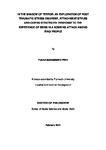In the Shadow of Terror: An Exploration of Post Traumatic Stress Disorder, Attachment Styles and Coping Strategies: Response to the Experience of being in a Bombing Attack among Iraqi People
| dc.contributor.supervisor | Dallos, Rudi | |
| dc.contributor.author | Freh, Fuaad Mohammed | |
| dc.contributor.other | School of Psychology | en_US |
| dc.date.accessioned | 2013-06-03T08:20:53Z | |
| dc.date.available | 2013-06-03T08:20:53Z | |
| dc.date.issued | 2013 | |
| dc.identifier | 10208278 | en_US |
| dc.identifier.uri | http://hdl.handle.net/10026.1/1488 | |
| dc.description.abstract |
Despite the widespread prevalence of bombing in Iraq, no study has investigated its psychological impact on civilians. This thesis aimed to address this gap in the literature. Four studies were conducted consequently using civilians in Iraq. The first study aimed to explore the subjective experience in response to the bombing attack. A qualitative approach was taken and twenty semi-structured interviews were employed and analysed using Interpretative Phenomenological Analysis (IPA). This identified seven categories including interpersonal relationships, loss of self, changes in attachment, shattering of world assumptions. Subsequent studies were then conducted to understand these themes as possible predictors of PTSD and psychiatric comorbidity in regards to bombing attacks. The second study was a prospective longitudinal design aimed to investigate the trajectory of PTSD symptoms, psychiatric comorbidity, and attachment styles among survivors. It also aimed to examine the role of a variety of variables, namely shattering of world assumptions, altered self-capacity, perceived social support to predict PTSD and psychiatric comorbidity. One hundred and eighty Iraqi civilians were recruited and assessed approximately 1 month and 5 months after their experience of being in a bombing attack using a battery of questionnaires. A control group data (n=178) of people who had not been exposed to a bombing was also collected. Results indicated that 19.4% and 57.2% of the participants met the screening criteria for partial and full PTSD symptoms at T1, which declined overtime. The bombing group displayed significantly higher rates of psychiatric comorbidity and insecure attachment than the control group. After controlling for the severity of bombing attack, controllability of events and affect dysregulation significantly predicted both PTSD and psychiatric co-morbidity symptoms. None of these dimensions predicted PTSD and psychiatric co-morbidity at T2. The complementary study 3 looked further at selected predictors indicated by the findings of study 1, namely death anxiety, coping strategies, religious coping and meaning in life. This study employed a longitudinal design in which 185 participants were recruited and assessed approximately 2 months and 7 months after bombing using a package of self-report questionnaires. Results indicated that religious coping and cognitive avoidance had a significant role to play in predicting PTSD and psychiatric comorbidity shortly after the bombing. Death anxiety was also emerged another picture in predicting PTSD and psychiatric comorbidity through mediators, namely religious coping and searching for meaning in life. Literature showed that PTSD and psychological distress are treatable after people had received various forms of professional and personal strategies. Study 4 employed mixed methods in order to provide further understanding regarding the helpful coping strategies that participants had attempted to use to manage their psychological distress. Six participants (n=3 recovered well, n=3 still struggle) were recruited for the qualitative phase and 243 for the quantitative. Social support was found as the most frequent and helpful strategy to manage post-bombing distress, followed by avoiding thinking about the bombing and religious strategies. Different psycho-social factors that hinder or foster recovery between participants were also highlighted. In conclusion, the findings confirmed related studies that, following bombing, there is a high risk that victims develop PTSD and psychiatric co-morbidity symptoms which decline to some extent over time. A variety of factors, such as social support and religious strategies were identified as helpful. However, these were also related to the victims’ prior attachment strategies. Implications for assisting victims and the population of Iraq are offered, in particular the need to support families and friends (social networks) in the context of very limited professional sources of support in a country where terrorism is rife. | en_US |
| dc.description.sponsorship | Ministry of Higher Education and Scientific research-Iraq | en_US |
| dc.language.iso | en | en_US |
| dc.publisher | University of Plymouth | en_US |
| dc.subject | Terror | en_US |
| dc.subject | PTSD | en_US |
| dc.subject | Psychiatric Co-morbidity | en_US |
| dc.subject | Bombing | en_US |
| dc.subject | Iraq | en_US |
| dc.title | In the Shadow of Terror: An Exploration of Post Traumatic Stress Disorder, Attachment Styles and Coping Strategies: Response to the Experience of being in a Bombing Attack among Iraqi People | en_US |
| dc.type | Thesis | |
| plymouth.version | Full version | en_US |
| dc.identifier.doi | http://dx.doi.org/10.24382/4740 | |
| dc.identifier.doi | http://dx.doi.org/10.24382/4740 |
Files in this item
This item appears in the following Collection(s)
-
01 Research Theses Main Collection
Research Theses Main


